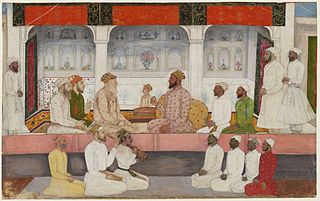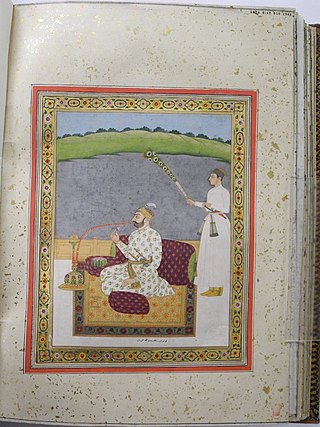Tihanpur branch
The Tihanpuri branch has the greatest claim to fame of all the branches of the dynasty. The branch began with Sayyid Jalal Khan Emir, 8th in descent from Abdullah al wasiti. Khan Emir left Tihanpur and settled in Dharsi located in the pargana of Jauli. He had four sons, of who the eldest Umar Shahid settled in Jansath, a second son Chaman settled in Chitaura and a third son Hassan settled in Bihari and a fourth Ahmad made his home in Kawal in the pargana of Jansath. [11]
Jansath

Umar found Jansath already occupied by Jats and Brahmins however during the branch's ascendancy in the later mughal era, the branch extended itself so much that Jansath became detached from the Jauli pargana.
It is also from this branch that the famous Nawab Abdullah Khan I emerged, better known in places like Ajmer as Sayyid Mian. The branch benefited from Aurangzeb's reign and by the time Aurangzeb passed away, the branch had considerable influence with Sayyid Mian's sons Nawab Hussain Ali Khan and Nawab Abdullah Khan II being attached to the future emperor Bahadur Shah. Nawab Hussain Ali Khan and Nawab Abdullah Khan II also known as the Sayyid Brothers were positioned such that when Bahadur Shah I ascended to the throne with the help of the brothers, he granted the former the government of Patna and the latter the government of Allahabad.
In 1709, Sayyid Ahmad, Sayyid Khan, Sayyid Hussain Khan and Sayyid Ghairat Khan all distinguished themselves in crushing a rebellion of Hindu Princes on the Narbada. During which they fought in the vanguard and all perished to a man with their followers. The Tihaanpuris continued to distinguish themselves in Punjab, Gujrat and along the Indus until they reach supremacy and became masters over South Asia.
In 1712, the sons of Sayyid Mian, having found themselves in a dangerous position and distrustful of other ministers at Delhi, took it upon themselves to raise Prince Furrukhsiyar to the throne as Emperor. During the process the sons of Sayyid Mian distinguished themselves in battle, with Sayyid Nurudin Ali Khan, Najmudin Ali Khan and Saifudin Ali Khan having fought gallantly in the battles of Sarai Alam Chand (Allahbad) and Agra. With Nurudin Ali Khan having lost his life at Allahbad.
Nawab Sayyid Hassan Ali Khan who thereafter became known as Abdullah Khan II, was appointed as Grand Vezier with the title of Qutb al Mulk, while Nawab Sayyid Hussain Ali Khan was appointed as Commander-in-Chief with the title of Amir ul Mammalik. In the demise of the Sayyid Brothers many other Sayyids of note fell with them, first with the assassination of Hussain Ali Khan and later at the Battle of Hasanpur where Abdullah Khan II was captured. Much of the Tihanpur Branch was destroyed by the efforts of Muhammad Amin Khan and Qamar ud din Khan, with only the Rohilla Dynasty having survived the general destruction of the Tihaanpuris [12]
Chaman
The branch of Chaman comes next in line to the Jansath branch. Descending from Sayyid Chaman who settled in Chitura, this branch gained much influence during the reign of Shah Jahan when Sayyid Jalal become a high ranking Mansabdar and was given possession of Kharwa Jalalpur in the Sardhan pargana of Meerut. However the branch fell in decline when Sayyid Shams, son of Sayyid Jalal left Imperial service. He had two sons, Sayyid Asghar Ali and Sayyid Asad Ali. The former died childless while the descendants of the latter remained in Chitura until the Biritsh era. [13]
Hassan
Sayyid Hassan had six sons, many of whom rose in imperial service and later became zamindars.
Ahmad
The descendants of Sayyid Ahmad who had settled in Kawal gained much acclaim during the reign of Aurangzeb when Tatar Khan and Diwan Muhammad Yar Khan became distinguished in imperial service.
Khan Jahan

Sayyid Nasirudin, the sixth son of Sayyid Hasan, gained much fame in the form of Sayyid Khanjahan-i-Shahjahanil, who attained much power under the emperor Shahjahan and was consequently granted forty villages in the parganas of Khatauli and Sarwat, along with several bighas of land in free revenue for perpetuity with the title of Abul Muzaffar He began to build a new town which was completed by his son and named Muzaffarnagar. [14]






















